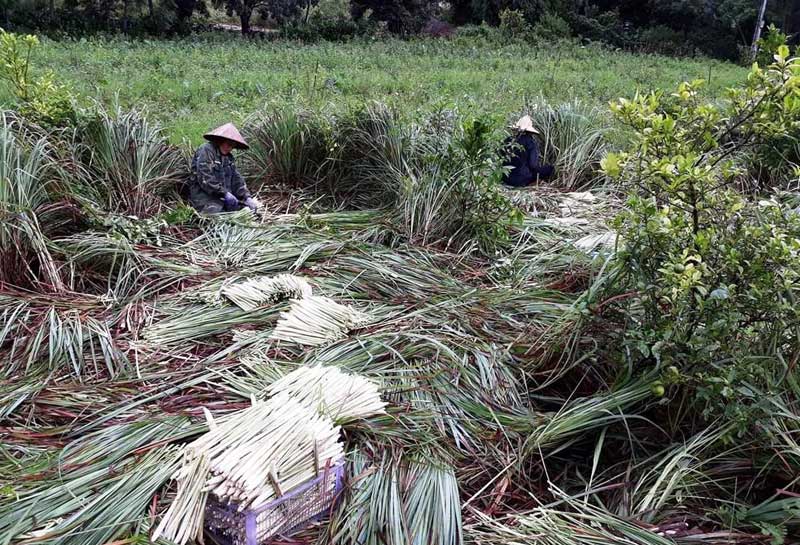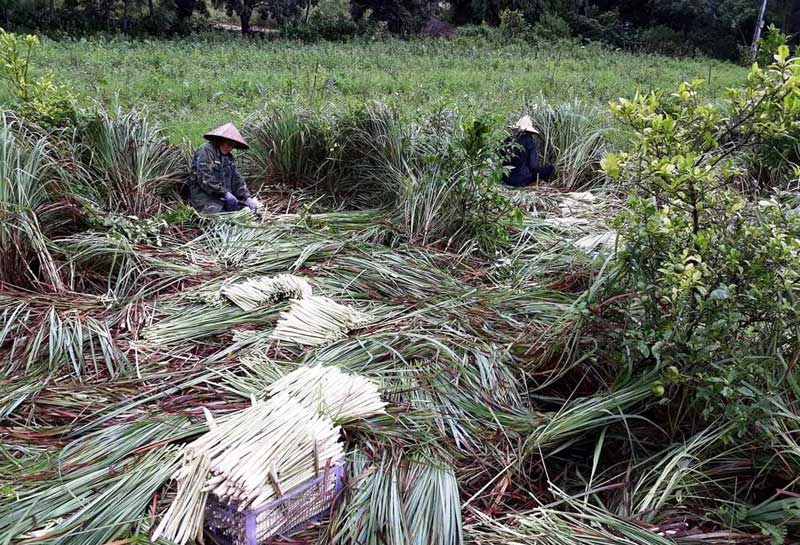
(HBO) - Hung Thi is one of the six difficult communes of Lac Thuy district, 90% of its population are Muong ethnic minority people. Their lives are still very difficult, and the economy is mainly dependent on forestation and livestock. Recognizing the economic benefits of lemongrass and its stable market consumption, the Committee and authorities of Hung Thi commune propagated and mobilized the local people to put lemongrass plants into growing on the land area of riverbank and hills. This makes the life of the farmers become quite well.

Lemongrass brings the income to the local
people of Tram village, Hung Thi commune
Talking to Mr. Pham Van Toan, the Head of
Tram village, we learn that: Up to now, the whole commune of Hung Thi has over
100 hectares of planting short hybrid lemongrass. This kind of plant is easy to
grow, easy to care, with nearly no disease; it can give high yield with the
time from planting to harvest of only 4.5 - 5 months. Two months later, another
crop can be collected. The harvesting period of lemongrass to be replanted is
after 3 years. On average, 1 hectare of lemongrass will be harvested for 5-7
crops, after deducting all the expenses, the farmers can earn the profit from
100-140 million VND / hectare.
For the people of Tram village, the village
9, the hamlet 8 and Mang village, at present, some house have about from some
perches to 1 hectare planting lemongrass, some other houses have up to 5 - 7
hectares. All products were collected by Mr. Pham Van Toan, the Head of Tram
village with prices ranging from 6,000 to 6,500 VND / kg, then they will be
sold to major wholesale markets in Hanoi and Vinh Phuc. According to Toan's
share, on average, he buys more than 2 tons of lemongrass roots every day. For
the months prior to Tet holiday, there are some days he collected dozens of
tons of lemongrass, but that amount didn’t meet the need of the market. In
addition to growing lemongrass in river banks, replacing the field bottom
planting vegetables before, lemongrass is also planted at the edge of the roads
or hill areas; it can be planted scattered in the fruit trees to help limit
weeds and increase the income for the local people.
According to data from the Hoa Binh Provincial Party Committee, the industrial production index for the first six months of 2025 is estimated to have increased by 20% compared to the same period last year. This marks the highest year-on-year growth rate for this period since 2020.
In the first six months of 2025, Hoa Binh province’s export turnover was estimated at 1.145 billion USD, marking an 18.11% increase compared to the same period in 2024. Import turnover was estimated at $ 804 million, a 17.15% increase, which helped the province maintain a positive trade balance.
The lives of the ethnic minority farmers in Tan Lac district have gradually improved thanks to the new directions in agricultural production. This is a testament to the collective strength fostered through the professional associations and groups implemented by various levels of the district’s Farmers’ Union.
With the motto the "product quality comes first,” after nearly one year of establishment and operation, Muong village’s Clean Food Agricultural and Commercial Cooperative, located in Cau Hamlet, Hung Son Commune (Kim Boi district), has launched reputable, high-quality agricultural products to the market that are well-received by consumers. The products such as Muong village’s pork sausage, salt-cured chicken, and salt-cured pork hocks have gradually carved out a place in the market and they are on the path to obtaining the OCOP certification.
In the past, the phrase "bumper harvest, rock-bottom prices" was a familiar refrain for Vietnamese farmers engaged in fragmented, small-scale agriculture. But today, a new spirit is emerging across rural areas of Hoa Binh province - one of collaboration, organisation, and collective economic models that provide a stable foundation for production.
Maintaining growing area codes and packing facility codes in accordance with regulations is a mandatory requirement for agricultural products to be eligible for export. Recently, the Department of Agriculture and Environment of Hoa Binh province has intensified technical supervision of designated farming areas and packing facilities to safeguard the "green passport" that enables its products to access international markets.



